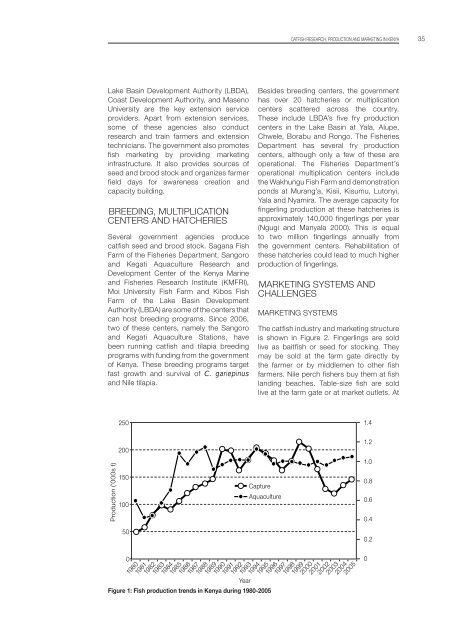Proceedings of a Workshop on the Development ... - World Fish Center
Proceedings of a Workshop on the Development ... - World Fish Center
Proceedings of a Workshop on the Development ... - World Fish Center
- No tags were found...
Create successful ePaper yourself
Turn your PDF publications into a flip-book with our unique Google optimized e-Paper software.
CATFISH RESEARCH, PRODUCTION AND MARKETING IN KENYA 35Lake Basin <strong>Development</strong> Authority (LBDA),Coast <strong>Development</strong> Authority, and MasenoUniversity are <strong>the</strong> key extensi<strong>on</strong> serviceproviders. Apart from extensi<strong>on</strong> services,some <str<strong>on</strong>g>of</str<strong>on</strong>g> <strong>the</strong>se agencies also c<strong>on</strong>ductresearch and train farmers and extensi<strong>on</strong>technicians. The government also promotesfish marketing by providing marketinginfrastructure. It also provides sources <str<strong>on</strong>g>of</str<strong>on</strong>g>seed and brood stock and organizes farmerfield days for awareness creati<strong>on</strong> andcapacity building.BREEDING, MULTIPLICATIONCENTERS AND HATCHERIESSeveral government agencies producecatfish seed and brood stock. Sagana <strong>Fish</strong>Farm <str<strong>on</strong>g>of</str<strong>on</strong>g> <strong>the</strong> <strong>Fish</strong>eries Department, Sangoroand Kegati Aquaculture Research and<strong>Development</strong> <strong>Center</strong> <str<strong>on</strong>g>of</str<strong>on</strong>g> <strong>the</strong> Kenya Marineand <strong>Fish</strong>eries Research Institute (KMFRI),Moi University <strong>Fish</strong> Farm and Kibos <strong>Fish</strong>Farm <str<strong>on</strong>g>of</str<strong>on</strong>g> <strong>the</strong> Lake Basin <strong>Development</strong>Authority (LBDA) are some <str<strong>on</strong>g>of</str<strong>on</strong>g> <strong>the</strong> centers thatcan host breeding programs. Since 2006,two <str<strong>on</strong>g>of</str<strong>on</strong>g> <strong>the</strong>se centers, namely <strong>the</strong> Sangoroand Kegati Aquaculture Stati<strong>on</strong>s, havebeen running catfish and tilapia breedingprograms with funding from <strong>the</strong> government<str<strong>on</strong>g>of</str<strong>on</strong>g> Kenya. These breeding programs targetfast growth and survival <str<strong>on</strong>g>of</str<strong>on</strong>g> C. gariepinusand Nile tilapia.Besides breeding centers, <strong>the</strong> governmenthas over 20 hatcheries or multiplicati<strong>on</strong>centers scattered across <strong>the</strong> country.These include LBDA’s five fry producti<strong>on</strong>centers in <strong>the</strong> Lake Basin at Yala, Alupe,Chwele, Borabu and R<strong>on</strong>go. The <strong>Fish</strong>eriesDepartment has several fry producti<strong>on</strong>centers, although <strong>on</strong>ly a few <str<strong>on</strong>g>of</str<strong>on</strong>g> <strong>the</strong>se areoperati<strong>on</strong>al. The <strong>Fish</strong>eries Department’soperati<strong>on</strong>al multiplicati<strong>on</strong> centers include<strong>the</strong> Wakhungu <strong>Fish</strong> Farm and dem<strong>on</strong>strati<strong>on</strong>p<strong>on</strong>ds at Murang’a, Kisii, Kisumu, Lut<strong>on</strong>yi,Yala and Nyamira. The average capacity forfingerling producti<strong>on</strong> at <strong>the</strong>se hatcheries isapproximately 140,000 fingerlings per year(Ngugi and Manyala 2000). This is equalto two milli<strong>on</strong> fingerlings annually from<strong>the</strong> government centers. Rehabilitati<strong>on</strong> <str<strong>on</strong>g>of</str<strong>on</strong>g><strong>the</strong>se hatcheries could lead to much higherproducti<strong>on</strong> <str<strong>on</strong>g>of</str<strong>on</strong>g> fingerlings.MARKETING SYSTEMS ANDCHALLENGESMARKETING SYSTEMSThe catfish industry and marketing structureis shown in Figure 2. Fingerlings are soldlive as baitfish or seed for stocking. Theymay be sold at <strong>the</strong> farm gate directly by<strong>the</strong> farmer or by middlemen to o<strong>the</strong>r fishfarmers. Nile perch fishers buy <strong>the</strong>m at fishlanding beaches. Table-size fish are soldlive at <strong>the</strong> farm gate or at market outlets. At250 1.4Producti<strong>on</strong> ('000s t)20015010050CaptureAquaculture1.21.00.80.60.40.201982198319841985198619871988198919801981199019911992199419951996199719981999200020011993YearFigure 1: <strong>Fish</strong> producti<strong>on</strong> trends in Kenya during 1980-200520022003200420050
















